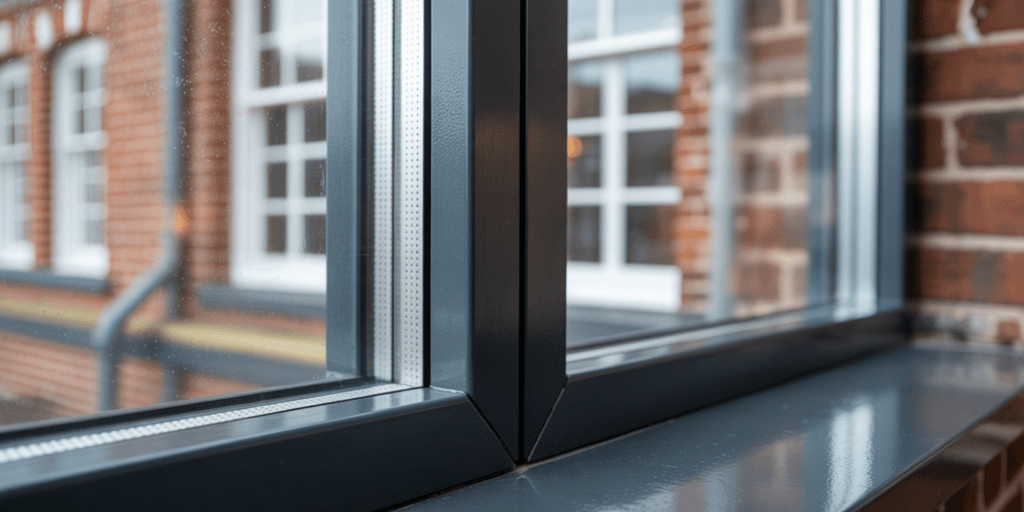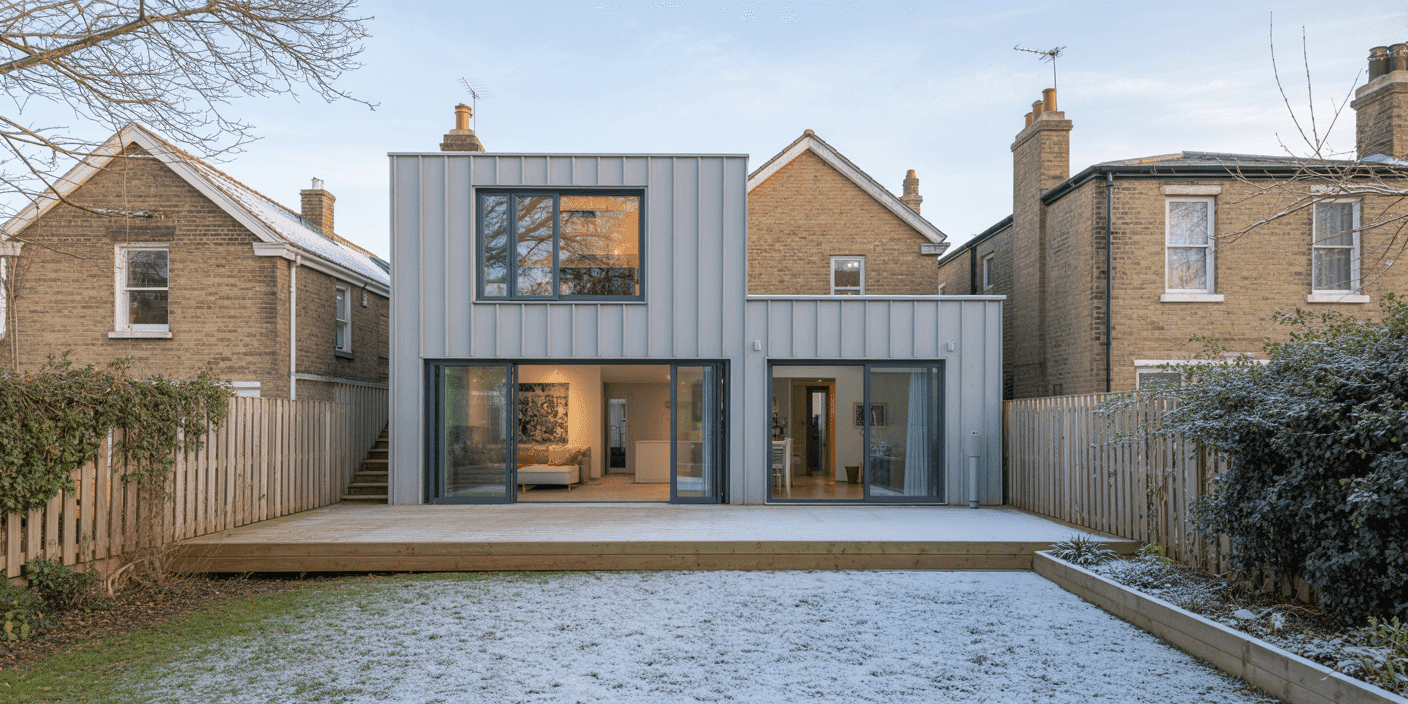Condensation Isn’t Cosmetic — It’s a Warning Sign
Condensation on high-performance glazing is not an aesthetic inconvenience. It is a diagnostic symptom — a visible signal that the window system is underperforming. Whether due to cold surface temperatures, elevated internal humidity, or flawed installation detailing, persistent condensation indicates a failure within the building envelope.
Left unaddressed, it encourages mould growth, accelerates frame decay, degrades finishes, and undermines thermal efficiency. In high-value homes, it does more than diminish comfort — it erodes confidence. A misted sash suggests deeper issues to buyers, surveyors, and compliance officers alike.
This is not a minor flaw. It is a breach in performance, design intent, and sometimes regulation.
Preventing condensation is not a matter of luck — it is a matter of precision. Success depends on rigorous specification, thermal modelling, airtight installation, and integrated ventilation design. When delivered by specialists who understand both the physics of performance and the architectural demands of heritage or bespoke settings, the result is not only clear — it’s enduring.
Why Even Passive Windows Can Fail
Just because a window is labelled “passive” doesn’t mean it will perform flawlessly in your home. In fact, some of the worst condensation problems occur behind triple-glazed, thermally-rated systems that looked perfect on paper — and then fogged up in real-world conditions.
That’s because passive window performance depends on far more than just the glass.
If the frame allows cold bridging, condensation will form.
If the ventilation strategy is poorly designed — or worse, ignored — warm, moist air will have nowhere to go.
If the low-E coating is positioned incorrectly, thermal gain can be compromised.
And if the installation lacks precision, all bets are off.
In airtight, modern buildings — or renovated period properties with upgraded insulation — internal humidity builds fast. Without proper airflow and edge temperature management, even premium windows become dew-point magnets.
The truth is, many passive systems are let down not by the product but by the process.
The wrong spacer bar. The wrong frame material. The wrong detailing.
And always, the wrong assumption: that performance on paper guarantees performance in practice.
It doesn’t. Real-world clarity requires real-world engineering. And that’s where most passive window failures begin — and end — with those who didn’t account for the building, the occupants, or the fine print in Part L and F.
The ones who do? You rarely hear about them — because their windows don’t talk back.
The Real Cost of Compromised Glazing

Condensation doesn’t just blur your view — it eats into your investment.
It starts quietly. A streak down the sash. A dark patch at the base of the frame. A vague smell in the corner of the room. But over time, that moisture becomes something more serious: a breeding ground for black mould, a trigger for respiratory issues, and an accelerant for frame decay — even in engineered timber or composite systems.
Worse, it undermines the very benefits that drove you to install passive windows in the first place.
A triple-glazed sash may claim to cut your energy bills, but if it’s gathering condensation each night, it’s failing to do so. The U-values might impress on paper, but the reality behind the curtain tells another story.
Then there’s resale.
Estate agents don’t need to say much when a buyer sees misty panes. Condensation makes homes feel neglected, poorly built, or improperly maintained — especially when paired with visible vents or compromised finishes. It’s the sort of detail that devalues even the most beautifully renovated home.
And in new builds or retrofits seeking EPC improvements or Part L compliance, it can derail the entire assessment.
Condensation isn’t just moisture. It’s mistrust in material form. It tells your clients — or your future buyers — that something isn’t working as promised.
For homeowners, that creates doubt.
For professionals, it creates callbacks.
For developers, it creates cost.
And all of it was preventable — with the right specification, the right installer, and the right attention to what happens after the glass goes in.
The Myth of the ‘Ugly Passive Window’
Somewhere along the way, performance started getting blamed for poor design. Chunky white uPVC frames. Awkward trickle vents cut through the top rail. Glazing bars that look more “budget brochure” than period Georgian.
The excuse?
“It’s the price you pay for Passive House compliance.”
Let’s be clear: that’s not design. That’s laziness dressed as engineering.
True passive windows don’t need to be bulky, boring, or visible from outer space. They can — and should — be elegant. Slim. Subtle. Almost indistinguishable from their heritage counterparts. And when done properly, they’re not just compliant — they’re beautiful.
Passive isn’t an aesthetic; it’s a standard. And it says nothing about how your window should look.
The myth persists because too many manufacturers serve the spec sheet, not the homeowner. They hit the U-value, ignore the sightline, and hand the problem over to the architect to “make it work.”
But the finest passive windows do both. They disappear into the elevation, respect the building’s DNA, and still deliver surface temperatures that prevent condensation, cold spots, and complaints.
And that’s the quiet brilliance of the right partner. One who doesn’t ask you to choose between warmth and authenticity. One who understands that elegance is part of performance — not its opposite.
Because a window that clears the moisture, but clouds the façade still fails the home.
The Science of Staying Clear
Preventing condensation isn’t about leaving the window open. It’s not about absorbent frames or wiping down the glass in winter. It’s about engineering — at a micro level — where every detail matters.
It begins at the edge.
Where glass meets spacer, inferior systems lose the battle. That’s where cold creeps in and droplets form. High-performance windows, by contrast, deploy warm-edge spacer bars — thermally non-conductive, built to keep the internal edge above dew point. No cold glass. No condensation. No compromise.
Then comes the coating.
Modern soft-coat low-E glass reflects interior heat back into the room, stabilising surface temperatures and improving comfort. But not all coatings are positioned correctly. A misplaced layer renders the whole assembly ineffective — a technical oversight masked until the mist appears.
The frame matters too. Timber alone won’t prevent thermal bridging. It must be supported with thermally broken sections — especially in composite or alu-clad builds — to block cold transfer and maintain consistent internal warmth.
But even the finest glass and frames will fail if installed poorly.
That’s why condensation prevention demands airtight detailing: compression seals, vapour control layers, and precision tolerances around every reveal. The smallest gaps undo the most expensive components.
And then, there’s the silent partner in all of this: ventilation.
Without it, every breath, every shower, every boil of the kettle raises indoor humidity — pushing vapour to the windows, where it collects. A proper Part F strategy — whether via concealed trickle vents or a whole-home MVHR system — ensures humidity leaves the building before it leaves its mark.
Condensation isn’t stopped with one product.
It’s defeated by a sequence:
Glass → Spacer → Frame → Install → Ventilation.
Get one wrong, and the system fails.
Get them all right, and the windows remain crystal clear — in any season, on any morning, for years to come.
What Passive Window Success Actually Looks Like

No noise. No mist. No chill in the morning air. Just silence, light, and clarity.
That’s what success looks like.
Not a checklist of U-values or a tick in a compliance box — but the invisible comfort of a system working so seamlessly, you forget it’s even there. You walk into the room and see your garden, not a fogged-up pane. You touch the glass on a February morning and feel warmth, not warning signs.
The house feels balanced. Quiet. Fresh without draughts. Warm without stuffiness. And the windows? They just sit there, elegantly framed, giving nothing away — except the light they let in and the heat they keep in.
There are no visible vents. No bulbous frames. No apology made in the name of performance. Just slender sightlines, historically faithful profiles, and joinery that feels as crafted as it is calculated.
This is what happens when passive principles meet artisan execution.
When thermal physics collaborates with heritage design.
When someone bothers to think about the whole system, not just the parts.
It’s not about the brand stamped on the spacer.
It’s about the experience delivered in the room.
And it doesn’t happen by accident.
It happens when the team on your project sees condensation not as a small annoyance, but as a symptom of larger failure — and then designs it out before the frame ever touches the wall.
That’s not overengineering.
That’s simply doing it properly.
The Signature Approach Behind the Results
Behind every clear pane is a process.
The kind of clarity that lasts all winter — and all warranty — doesn’t come from luck or branding. It comes from understanding exactly how glass, frame, installation, humidity and architecture interact. And getting it right from the first sketch to the final seal.
Some firms supply windows.
Others engineer solutions.
The difference? One works off-the-shelf. The other works off your building.
That means choosing not just the correct U-value, but the right low-E placement for the orientation. It means adjusting spacer selection based on frame depth and climate exposure. It means knowing when to specify thermally broken alu-clad over engineered timber — and how to detail it so it disappears into a Georgian elevation.
It means solving ventilation before it becomes a problem.
It means understanding Part L, Part Q, and Part F — not as checkboxes, but as lived experience in planning meetings, EPC surveys, and on-site inspections.
It also means respecting beauty.
A true solution doesn’t scream performance. It hums elegance. The right finish. The right reveal. The right amount of nothing on show.
And while no name may appear in bold across the page, the fingerprint is there — in the joinery mitre, the hidden trickle vent, the steady warmth beneath the sill.
When condensation doesn’t happen, it’s because every stage of the process was built to prevent it.
That’s the signature.
And once you know what to look for, you’ll see it in every window we’ve left behind.
Want Crystal-Clear Windows, All Year Round?
You shouldn’t have to wipe down your windows.
You shouldn’t have to apologise for the view.
And you absolutely shouldn’t have to choose between performance and beauty.
If you’re seeing condensation — or simply want to be sure you never will — it’s time to take action. Not with off-the-shelf systems, rushed installers, or contractors guessing at compliance… but with people who see the entire picture before they even see the job.
Whether you’re specifying for a listed property, retrofitting a period terrace, or building to Passive House standards — the condensation-free result you’re imagining already exists.
And it starts with a conversation.
✅ Book your Passive Window Audit
✅ Request our ‘Clear-View’ Compliance Spec Pack
✅ Talk to a project specialist — before the fog sets in
Because when it’s done properly, condensation doesn’t stand a chance.
And neither does compromise.







